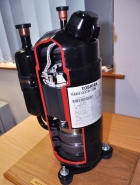Toshiba breaks new ground with VRF air conditioning

Toshiba’s SMMS-e VRF heat-pump air-conditioning system features three core technologies to contribute to an ESEER (European Seasonally Adjusted Energy Efficiency Rating) higher than seven. With the SMMS-e, it is possible to connect up to 60 hp in a single system, with up to 64 connectable indoor units, considerably more than the previous 48 hp. Maximum pipework length is 1000 m, double the previous length.
A new rotary compressor (pictured) developed and manufactured by Toshiba uses a 2-stage compression process to improve efficiency and performance. Wear surfaces on compression vanes have a special treatment to give outstanding hardness, wear resistance and reliability. The resulting increased rotation speed enables a higher capacity to be obtained from a smaller compressor, with less power.
The rotational speed of the compressor can be adjusted in 0.1 Hz steps to give very precise response to demand.
The heat exchanger has been completely redesigned. It uses smaller-diameter tubes arranged in three rows in the coil, compared with two rows previously, resulting in a 13% increase in surface area.
The capacity of the heat exchanger, previously fixed, can be adjusted to match the current load and ambient conditions. The 3-way variable heat exchanger enables the control system to automatically select the optimum setting.
100% of the heat-exchange capacity is used to deliver full cooling in high outdoor ambients. 80% of heat-transfer is employed in average outdoor temperatures. At the lowest setting, 20% of capacity provides gentle operation when outdoor temperatures are low.
SMMS-e can provide continuous heating, with no requirement to stop during defrosts. This is made possible by a new hot-gas bypass control that simultaneously defrosts outdoor heat-exchanger coils while allowing the indoor unit to continue operating in heating mode.
Controls can vary the amount of refrigerant to each indoor unit based on the difference in temperature detected by two sensors on each FCU.
For installers, a wireless commissioning and performance validation tool enables engineers to read and write data to the condensing unit using a smart phone without making physical contact. Testing and commissioning can be carried out without taking the covers off the unit.
A maximum of 40 m between indoor units is enough to cover an entire 11-storey building.







